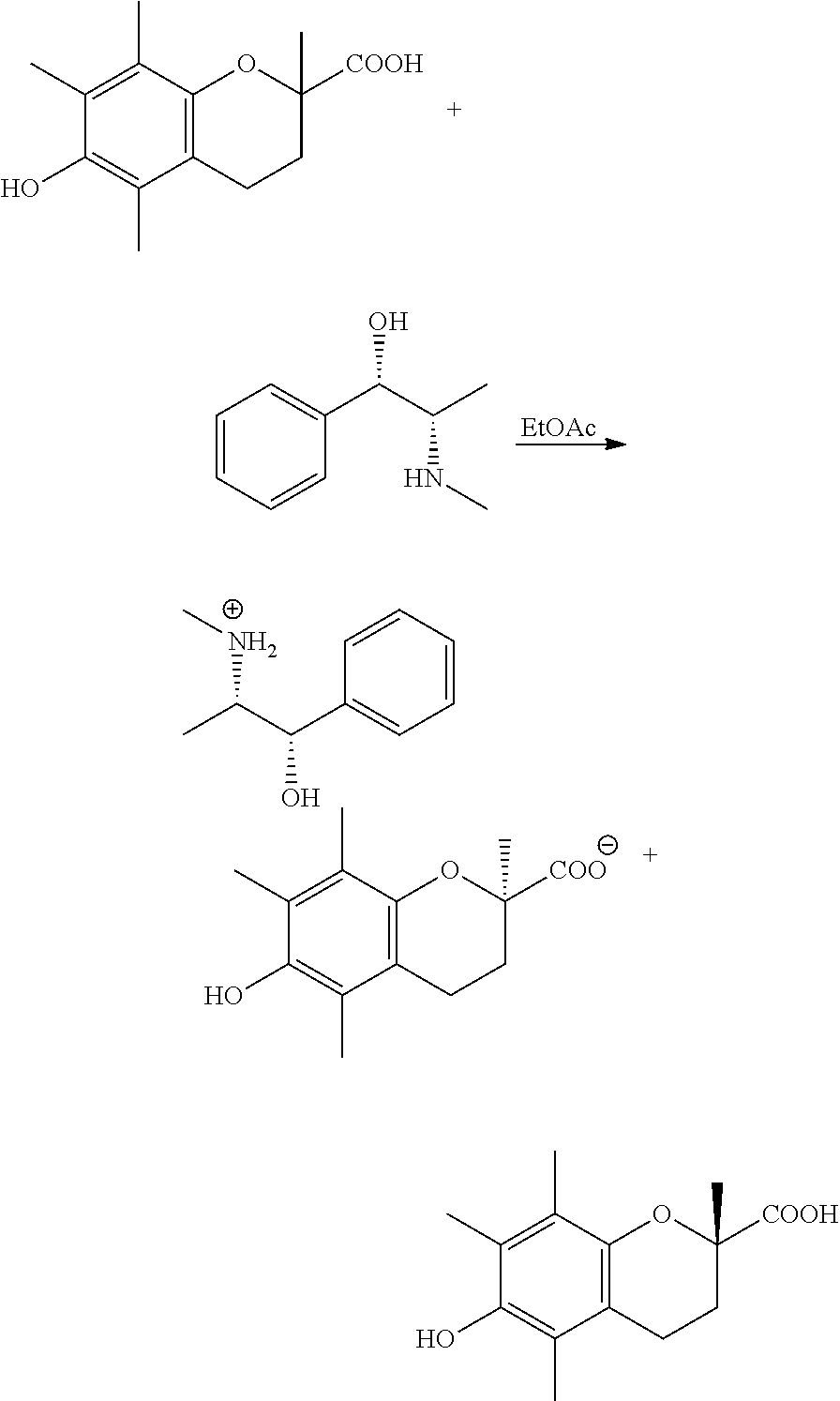Methods for chiral resolution of trolox
- Summary
- Abstract
- Description
- Claims
- Application Information
AI Technical Summary
Benefits of technology
Problems solved by technology
Method used
Image
Examples
example 1
Solubility Assessment of (R)-Trolox
[0079](R)-Trolox (97.89% ee, chemical purity>99.99% AUC) (100 mg) was weighed out in 12 different vials. 12 different solvents were added (one volume at a time) to the different vials and the mixture was maintained at 40° C. The volume of each solvent required to dissolve 100 mg of (R)-Trolox was recorded and the solubility was subsequently calculated. Solubility data is presented in Table 1.
TABLE 1Solubility assessment of (R)-TroloxAmt of solventSolubilityat 40° C.at 40° C.(R)-Trolox (mg)Solvent(μL)(mg / mL)97.7water>3.5 mLnot soluble100.4MeOH100100498.7EtOH200494104.5IPA200523100.8IPAc400252104.6EtOAc50020997.4ACN500195104.82-MeTHF200524103.95% water / MeOH1001039102.55% water / EtOH12085497.85% water / IPA100978100.95% water / ACN220459
[0080](R)-Trolox was found to be highly soluble in all solvents except for pure water. Isopropyl acetate (IPAc), 2-methyltetrahydrofuran (2-MeTHF), and 5% water / isopropyl alcohol (v / v) were chosen for the initial salt scree...
example 2
Initial Salt Screening Experiments Using (R)-Trolox
[0081](R)-Trolox (4.00 g) was weighed out in a vial and dissolved in ˜20 mL of EtOH. The total volume of this solution was measured out to be 22.3 mL. Therefore, 0.558 mL of this solution corresponded to 100 mg of (R)-Trolox. 1.05 eq. (100 mg of (R)-Trolox=1 eq.) of each base was weighed out in 39 different vials (3 vials per base). 0.558 mL of the (R)-Trolox solution was added to each vial and the solvent was evaporated slowly in a vacuum oven at RT. 0.500 mL of each solvent (a: IPAc, b: 2-MeTHF, and c: 5% water / IPA) was added to the appropriate vial and the solution was stirred at 40° C. for 1.5 hours using magnetic stirrer. Then, the solution was cooled down to RT for at least 1.5 hours. If solids precipitated, they were filtered and analyzed by XRPD and optical microscopy. If no solids precipitated, the solvent was evaporated slowly (uncapping of the vial) at RT overnight. If solids were obtained after evaporation, they were ana...
example 3
Additional Salt Screening Experiments Using (R)-Trolox
[0084](R)-Trolox (1.70 g) was weighed out in a vial and dissolved in ˜8.5 mL of EtOH. The total volume of this solution was measured out to be 8.8 mL. Therefore, 0.518 mL of this solution corresponded to 100 mg of (R)-Trolox. 1.05 eq. (100 mg of (R)-Trolox=1 eq.) of each base was weighed out in 12 different vials (3 vials per base). 0.518 mL of the (R)-Trolox solution was added to each vial (plus 3 empty vials as controls) and the solvent was evaporated slowly in a vacuum oven at RT. 0.500 mL of each solvent (a: IPAc, b: 2-MeTHF, and c: 5 water / IPA) was added to the appropriate vial and the solution was stirred at 40° C. for 1.5 hours using magnetic stirrer. Then, the solution was cooled down to RT for at least 1.5 hours. If solids precipitated, they were filtered and analyzed by XRPD and optical microscopy. If no solids precipitated, the solvent was evaporated slowly (uncapping of the vial) at RT overnight. If solids were obtain...
PUM
| Property | Measurement | Unit |
|---|---|---|
| Temperature | aaaaa | aaaaa |
| Temperature | aaaaa | aaaaa |
| Temperature | aaaaa | aaaaa |
Abstract
Description
Claims
Application Information
 Login to View More
Login to View More - R&D
- Intellectual Property
- Life Sciences
- Materials
- Tech Scout
- Unparalleled Data Quality
- Higher Quality Content
- 60% Fewer Hallucinations
Browse by: Latest US Patents, China's latest patents, Technical Efficacy Thesaurus, Application Domain, Technology Topic, Popular Technical Reports.
© 2025 PatSnap. All rights reserved.Legal|Privacy policy|Modern Slavery Act Transparency Statement|Sitemap|About US| Contact US: help@patsnap.com



